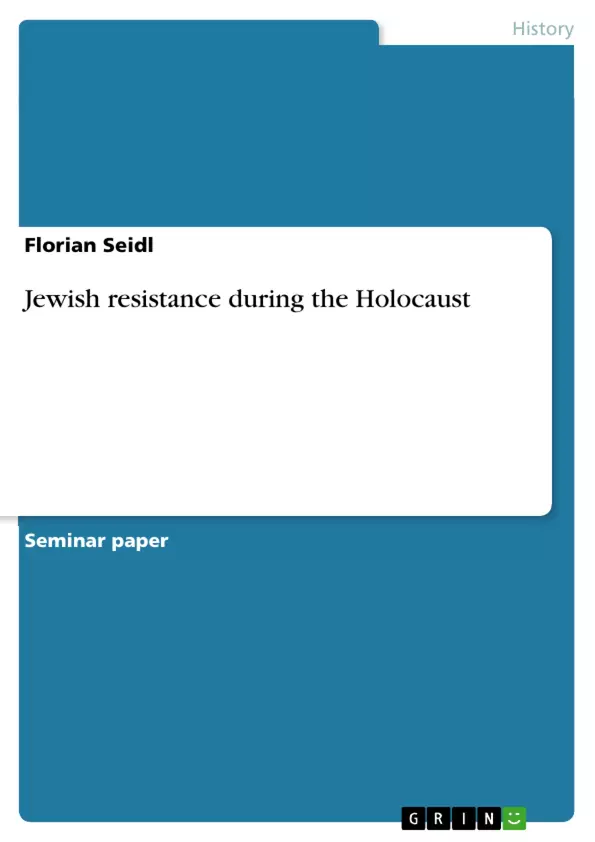This essay is basically a critical discussion of the statement: "The common cliché that Jews did not resist their persecutors and simply went ′like sheep to the slaughter′ is neither an accurate nor a fair description."
Inhaltsverzeichnis (Table of Contents)
- Jewish resistance during the Holocaust
- During the last decades
- But in spite of this
- Which kinds of actions and reactions of Jews during the Holocaust
- The kinds of resistance that match into the first three categories
- Resistance understood this way
- Especially in the Ghettos
Zielsetzung und Themenschwerpunkte (Objectives and Key Themes)
This paper critically analyzes the statement that Jews did not resist their persecutors during the Holocaust, challenging the common cliché that they went "like sheep to the slaughter." It aims to explore the various forms of resistance exhibited by Jewish individuals and communities, dispelling the myth of passive victimhood.
- The History of Jewish Resistance
- Debunking the Myth of Passivity
- The Spectrum of Resistance
- The Importance of "Quiet Resistance"
- The Struggle for Survival and Dignity
Zusammenfassung der Kapitel (Chapter Summaries)
- Jewish resistance during the Holocaust: This chapter introduces the historical context and early perspectives on Jewish resistance during the Holocaust, highlighting the prevalence of the "sheep to the slaughter" narrative. It critiques the works of Hanna Arendt and Raul Hilberg, who focused on the passivity of Jews, and examines the prevailing view that Jewish culture and values fostered submissiveness.
- During the last decades: This section discusses the shift in historical research, emphasizing the efforts to challenge the perception of Jews as passive victims. It explores the motivations behind this re-evaluation, including the desire to correct the distorted image of Jewish collaboration and the need to recognize the complexities of resistance.
- But in spite of this: This chapter delves into the persistence of Hilberg's perspective, which maintains the rarity and isolation of Jewish resistance efforts. It highlights the criticism of Hilberg's views and emphasizes the importance of new evidence, particularly from the Yad Vashem Archives, in understanding the spectrum of Jewish responses to the Holocaust.
- Which kinds of actions and reactions of Jews during the Holocaust: This section examines the various forms of resistance exhibited by Jewish individuals and communities during the Holocaust, emphasizing the need to move beyond the narrow definition of armed resistance. It introduces the classification scheme of Werner Rings, which categorizes resistance based on the types of commitments and actions of resisters.
- The kinds of resistance that match into the first three categories: This chapter focuses on "quiet resistance," which encompasses unarmed forms of resistance like symbolic, polemic, and defensive resistance. It explores the motivations behind this type of resistance, emphasizing the desire to maintain humanity and dignity in the face of oppression and murder.
- Resistance understood this way: This section discusses the concept of resistance as an "active struggle for life" and examines the importance of maintaining a degree of normality amidst the horrors of the Holocaust. It introduces the concept of "Kiddush ha-Hayyim" (Sanctification of Life) as a form of resistance that emphasizes preserving dignity and human values.
- Especially in the Ghettos: This chapter explores the various ways in which Jewish communities in ghettos resisted Nazi persecution. It highlights the importance of maintaining social services, cultural activities, and religious practices, even under extremely difficult conditions, as a form of resistance. It also discusses the role of smuggling and mutual aid networks in helping the Jewish population survive.
Schlüsselwörter (Keywords)
Jewish Resistance, Holocaust, Nazi Persecution, Passivity, Victimhood, Spectrum of Resistance, Quiet Resistance, Kiddush ha-Hayyim (Sanctification of Life), Ghettos, Smuggling, Mutual Aid, Yad Vashem Archives.
- Citar trabajo
- Florian Seidl (Autor), 2004, Jewish resistance during the Holocaust, Múnich, GRIN Verlag, https://www.grin.com/document/57875



